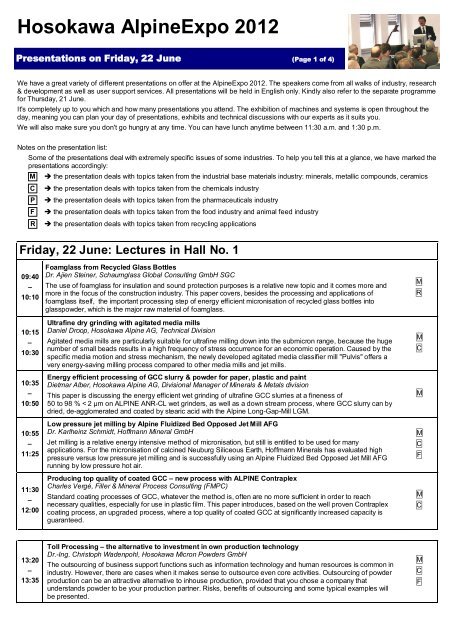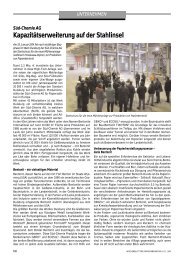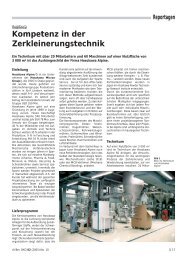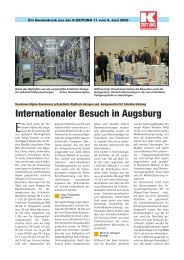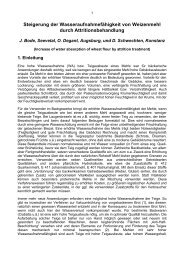Presentations Fr. 22.06.2012 - Hosokawa Alpine Aktiengesellschaft
Presentations Fr. 22.06.2012 - Hosokawa Alpine Aktiengesellschaft
Presentations Fr. 22.06.2012 - Hosokawa Alpine Aktiengesellschaft
Create successful ePaper yourself
Turn your PDF publications into a flip-book with our unique Google optimized e-Paper software.
<strong>Hosokawa</strong> <strong>Alpine</strong>Expo 2012<br />
<strong>Presentations</strong> on <strong>Fr</strong>iday, 22 June (Page 1 of 4)<br />
We have a great variety of different presentations on offer at the <strong>Alpine</strong>Expo 2012. The speakers come from all walks of industry, research<br />
& development as well as user support services. All presentations will be held in English only. Kindly also refer to the separate programme<br />
for Thursday, 21 June.<br />
It's completely up to you which and how many presentations you attend. The exhibition of machines and systems is open throughout the<br />
day, meaning you can plan your day of presentations, exhibits and technical discussions with our experts as it suits you.<br />
We will also make sure you don't go hungry at any time. You can have lunch anytime between 11:30 a.m. and 1:30 p.m.<br />
Notes on the presentation list:<br />
Some of the presentations deal with extremely specific issues of some industries. To help you tell this at a glance, we have marked the<br />
presentations accordingly:<br />
M<br />
C<br />
� the presentation deals with topics taken from the industrial base materials industry: minerals, metallic compounds, ceramics<br />
� the presentation deals with topics taken from the chemicals industry<br />
� the presentation deals with topics taken from the pharmaceuticals industry<br />
� the presentation deals with topics taken from the food industry and animal feed industry<br />
� the presentation deals with topics taken from recycling applications<br />
<strong>Fr</strong>iday, 22 June: Lectures in Hall No. 1<br />
09:40<br />
–<br />
10:10<br />
10:15<br />
–<br />
10:30<br />
10:35<br />
–<br />
10:50<br />
10:55<br />
–<br />
11:25<br />
11:30<br />
–<br />
P<br />
F<br />
R<br />
12:00<br />
13:20<br />
–<br />
13:35<br />
Foamglass from Recycled Glass Bottles<br />
Dr. Ajien Steiner, Schaumglass Global Consulting GmbH SGC<br />
The use of foamglass for insulation and sound protection purposes is a relative new topic and it comes more and<br />
more in the focus of the construction industry. This paper covers, besides the processing and applications of<br />
foamglass itself, the important processing step of energy efficient micronisation of recycled glass bottles into<br />
glasspowder, which is the major raw material of foamglass.<br />
Ultrafine dry grinding with agitated media mills<br />
Daniel Droop, <strong>Hosokawa</strong> <strong>Alpine</strong> AG, Technical Division<br />
Agitated media mills are particularly suitable for ultrafine milling down into the submicron range, because the huge<br />
number of small beads results in a high frequency of stress occurrence for an economic operation. Caused by the<br />
specific media motion and stress mechanism, the newly developed agitated media classifier mill "Pulvis" offers a<br />
very energy-saving milling process compared to other media mills and jet mills.<br />
Energy efficient processing of GCC slurry & powder for paper, plastic and paint<br />
Dietmar Alber, <strong>Hosokawa</strong> <strong>Alpine</strong> AG, Divisional Manager of Minerals & Metals division<br />
This paper is discussing the energy efficient wet grinding of ultrafine GCC slurries at a fineness of<br />
50 to 98 % < 2 µm on ALPINE ANR-CL wet grinders, as well as a down stream process, where GCC slurry can by<br />
dried, de-agglomerated and coated by stearic acid with the <strong>Alpine</strong> Long-Gap-Mill LGM.<br />
Low pressure jet milling by <strong>Alpine</strong> Fluidized Bed Opposed Jet Mill AFG<br />
Dr. Karlheinz Schmidt, Hoffmann Mineral GmbH<br />
Jet milling is a relative energy intensive method of micronisation, but still is entitled to be used for many<br />
applications. For the micronisation of calcined Neuburg Siliceous Earth, Hoffmann Minerals has evaluated high<br />
pressure versus low pressure jet milling and is successfully using an <strong>Alpine</strong> Fluidized Bed Opposed Jet Mill AFG<br />
running by low pressure hot air.<br />
Producing top quality of coated GCC – new process with ALPINE Contraplex<br />
Charles Vergé, Filler & Mineral Process Consulting (FMPC)<br />
Standard coating processes of GCC, whatever the method is, often are no more sufficient in order to reach<br />
necessary qualities, especially for use in plastic film. This paper introduces, based on the well proven Contraplex<br />
coating process, an upgraded process, where a top quality of coated GCC at significantly increased capacity is<br />
guaranteed.<br />
Toll Processing – the alternative to investment in own production technology<br />
Dr.-Ing. Christoph Wadenpohl, <strong>Hosokawa</strong> Micron Powders GmbH<br />
The outsourcing of business support functions such as information technology and human resources is common in<br />
industry. However, there are cases when it makes sense to outsource even core activities. Outsourcing of powder<br />
production can be an attractive alternative to inhouse production, provided that you chose a company that<br />
understands powder to be your production partner. Risks, benefits of outsourcing and some typical examples will<br />
be presented.<br />
M<br />
R<br />
M<br />
C<br />
M<br />
M<br />
C<br />
F<br />
M<br />
C<br />
M<br />
C<br />
F
<strong>Hosokawa</strong> <strong>Alpine</strong>Expo 2012<br />
<strong>Presentations</strong> on <strong>Fr</strong>iday, 22 June (Page 2 of 4)<br />
<strong>Fr</strong>iday, 22 June: Lectures in Hall No. 1<br />
13:40<br />
–<br />
13:55<br />
14:00<br />
–<br />
14:30<br />
14:40<br />
–<br />
15:10<br />
15:15<br />
–<br />
15:35<br />
15:40<br />
–<br />
15:55<br />
16:00<br />
–<br />
16:30<br />
Continous improvement of energy efficiency<br />
Tobias Ruta, Endress+Hauser Messtechnik GmbH & Co. KG<br />
Accurate and reliable metering ensures the analysis of energy flows and assist in the Detectability of savings.<br />
Independent energy consultancy and realization of projects ensures the achievement of targets.<br />
Energy efficient, resource preservating processes and renewable materials – a nucleus for innovations in<br />
process engineering<br />
Prof. Dr.-Ing. Wolfgang Rommel, Head of Master Course Environmental and Process Technology of Augsburg<br />
University of Applied Sciences, Managing Director of bifa Environmental Institute, Augsburg<br />
The world-wide demographic development combined with increasing standards of life caused an exponentially<br />
increase of natural resource consumption. The ecological limits of quantitative growth have been reached! In<br />
general, that means that the resource intensity and efficiency have to be dramatically increased. This is due for<br />
almost all production processes. Mechanical and comminution processes play a very important role in feed stock<br />
and raw material exploitation, material production and processing as well as in recycling processes. On one hand,<br />
these processes are rather energy consuming and on the other hand they are part of the material supply chain and<br />
thus determine the material efficiency significantly. Hence, major task in process engineering is to increase the<br />
degree of efficiency of comminution and material handling operations. Certainly, this is a big challenge, but it also<br />
offers a lot of options and thus will be the nucleus for innovations in process engineering.<br />
This lecture will give some selected samples:<br />
� preparation and processing of biomass for bio-degradable plastics, solid and liquid bio fuel<br />
� separation of material composites<br />
� crushing of carbon-fiber-composite parts as a pre-step for pyrolysis recycling<br />
Fine particle processing and Energy saving – a contradiction?<br />
Dr. Jürgen Stein, <strong>Hosokawa</strong> <strong>Alpine</strong> AG, Technical Division<br />
Actual discussions about energy saving in all areas of life and industry marks fine particle processes due to the low<br />
efficiency as archaic. To increase the efficiency a new approach is necessary. In principle three areas can be<br />
defined to optimize a fine particle processing system: machine technology, process control and product properties.<br />
A significant energy reduction can be reached by intelligent linking of all these aspects and parameters.<br />
Fine particle processing and Energy saving by intelligent process control<br />
Gerhard Kiederle, <strong>Hosokawa</strong> <strong>Alpine</strong> AG, Technical Division<br />
A key to increase the energy efficiency of a fine particle process is an intelligent process control. For intelligent<br />
process controls a lot of theoretical approaches are on the market. Most tend to be complicated. <strong>Hosokawa</strong> <strong>Alpine</strong><br />
developed a practical solution, which allows an intelligent control of a fine particle process with a manageable<br />
effort.<br />
Fine particle processing and Energy saving by inline particle size measurement<br />
Hans Kaiser, <strong>Hosokawa</strong> <strong>Alpine</strong> AG, Technical Division<br />
Intelligent measurement systems help to increase the understanding of powder production processes. One of<br />
these systems is an inline particle measurement. How this knowledge can be used to optimize a powder process is<br />
shown on different case studies.<br />
Efficiency in flue gas cleaning with NaHCO3 by activation by grinding<br />
Dr. Bernd Morun, DrySoTec GmbH<br />
Long term experience with: -dependency of activity from the grade of grinding; - particle uniformity after grinding;<br />
-maintenance and problems gained in practice.<br />
M<br />
C<br />
F<br />
R<br />
M<br />
C<br />
F<br />
R<br />
M<br />
C<br />
P<br />
F<br />
M<br />
C<br />
P<br />
F<br />
M<br />
C<br />
P<br />
F<br />
C
<strong>Hosokawa</strong> <strong>Alpine</strong>Expo 2012<br />
<strong>Presentations</strong> on <strong>Fr</strong>iday, 22 June (Page 3 of 4)<br />
<strong>Fr</strong>iday, 22 June: Lectures in Hall No. 2<br />
09:20<br />
–<br />
09:35<br />
09:40<br />
–<br />
10:10<br />
10:15<br />
–<br />
10:30<br />
10:35<br />
–<br />
10:50<br />
10:55<br />
–<br />
11:25<br />
11:30<br />
–<br />
12:00<br />
12:05<br />
–<br />
12:20<br />
Rotary blowers – the way from single units to blower stations<br />
Dietmar Liebig, KAESER Kompressoren AG<br />
KAESER rotary blowers deliver the means for conveying powder and granulate material (also for nitrogen<br />
environments), either by suction or blowing (description and function). New rotary blowers complete ready for<br />
operation with integrated electric and control. Blower stations as centralised, highly efficient sources of high quality<br />
blowing, suction or cooling air. KAESER management systems are able to control and coordinate operation of<br />
several units within a blower station.<br />
Cryogen Fine Grinding and Cryogen Separation of Composite Materials<br />
Dipl.-Ing. (FH) Oliver Dietrich, Messer Group GmbH<br />
Cold grinding process with a counter rotating pin mill. Detailed descriptions of<br />
- fine grinding process with rubber and thermoplastic materials,<br />
- the separation of composite materials as garden hoses (fibre reinforced soft PVC) and<br />
- examples of food and spice grinding processes.<br />
The use of Zetapotential measurement for the charactisation of dispersion stability<br />
Dr. Mark Wingfield, Malvern Instruments GmbH<br />
Electrostatic stabilisation of particles is commonly used in the formulation of dispersions and wet milling techniques.<br />
The measurement of Zetapotential to characterise electrostatic interactions of particles will be described and the<br />
characterisation of dispersion stability will be discussed.<br />
Production of Reproductive Energy by means of Compaction<br />
Robert Rosen, <strong>Hosokawa</strong> Bepex GmbH<br />
Wood chips are used to generate energy at smaller power stations. Due to high demand, lack of sources and price<br />
increase is already noticed. By means of a new developed process harvested maize from corn is crushed, dried and<br />
compacted. So called slaps have a higher density and a 40 % higher calorific value compared with wood chips.<br />
Technologies for Particle Shape Design<br />
Dr. Jürgen Stein, <strong>Hosokawa</strong> <strong>Alpine</strong> AG, Technical Division<br />
Beside fineness and particle size distribution, the particle shape becomes increasingly important for many<br />
applications. If milling or synthesis do not create a functional particle shape or morphology, it is necessary to apply<br />
further processing steps. Particle shape can be modified by either mechanical or thermal treatment or a combination<br />
of it. The presentation will show different technologies for the production of particles with tailored shape and some<br />
examples of application.<br />
Graphite Powder Processing - A Key Element for High Performance Li-Ion Batteries<br />
Dr.-Ing. Oswin Öttinger, U. Bosch, B. Ketterer, SGL CARBON GmbH<br />
Today, lithium-ion technology finds its largest growth potential in the upcoming electromobility market. Within the<br />
battery of an electric car, several kilograms of graphite powder are used as an active intercalation material to store<br />
lithium. The performance of the battery (e.g., efficiency, cycling stability, lifetime, and safety) depends to a large<br />
extent on the quality and the characteristics of the graphite material. Therefore, graphite powder processing is<br />
regarded as one key element in the production chain for high-grade Li-ion cells.<br />
Process Technology for High Performance Battery materials<br />
Dr. Yoshiyuki Inoue, <strong>Hosokawa</strong> Micron Corp. (Japan)<br />
Powder processing is important technology for manufacturing the high performance battery materials (for anode and<br />
cathode). Two major technologies are introduced in this presentation:<br />
1. Fine milling without metal contamination with high throughput<br />
2. Economic surface enhancement for improvement the electric conductivity, cyclic performance, heat stability,<br />
capacity, etc,<br />
M<br />
C<br />
F<br />
R<br />
C<br />
P<br />
F<br />
M<br />
C<br />
P<br />
F<br />
F<br />
R<br />
M<br />
C<br />
P<br />
M<br />
C<br />
M<br />
C
<strong>Hosokawa</strong> <strong>Alpine</strong>Expo 2012<br />
<strong>Presentations</strong> on <strong>Fr</strong>iday, 22 June (Page 4 of 4)<br />
<strong>Fr</strong>iday, 22 June: Lectures in Hall No. 2<br />
13:30<br />
–<br />
14:00<br />
14:05<br />
–<br />
14:20<br />
14:25<br />
–<br />
14:40<br />
14:45<br />
–<br />
15:00<br />
15:05<br />
–<br />
15:35<br />
15:40<br />
–<br />
15:55<br />
16:00<br />
–<br />
16:15<br />
16:20<br />
–<br />
16:35<br />
Protective Systems for Explosion Protection - When do we really need them<br />
Dr. Bernd Broeckmann, INBUREX Consulting GmbH<br />
Protective Systems for explosion protection are sometimes seen as investment cost and intensive additional means.<br />
The presentation will line out under which conditions these protective systems are either legally required, required<br />
by physics due to specific effects or required by risk management considerations.<br />
The new standard DIN EN 16009 – flameless explosion protection, a benefit for the clients<br />
Dipl.-Ing. Roland Bunse, REMBE® GMBH SAFETY + CONTROL, Head of Explosion Protection Department<br />
EN standard 16009 provides the customer with yet another seal of quality. The EC-Type Examination Certificate<br />
according to EN standards 16009 should be the most important criterion when selecting a product for flameless<br />
explosion venting. This presentation shows the performance of the Flameless Venting device during the DIN EN<br />
16009 certification and outlines the benefits for the customers in cost saving e.g. maintenance costs.<br />
The <strong>Alpine</strong> Long-Gap-Mill LGM: Applications from the Chemical, Food, Mineral & Recycling industry<br />
Christof Barth, <strong>Hosokawa</strong> <strong>Alpine</strong> AG, Minerals & Metals division<br />
The ALPINE Long-Gap-Mill LGM is a universal mill, which is used in a very wide field of applications for grinding,<br />
drying, de-agglomeration, simultaneous grinding & drying or coating in all kind of industries. This paper is<br />
presenting selected applications from the chemical, food, mineral & recycling industry by use of the LGM mill.<br />
Energy saving new developed ALPINE ultrafine classifier TurboTwinDouble TTD. Revamping of existing<br />
ball mill classifier loops by TTD.<br />
Dietmar Alber, <strong>Hosokawa</strong> <strong>Alpine</strong> AG, Divisional Manager of Minerals & Metals division<br />
Energy saving is not only a topic in the Western World, but also becomes a topic in countries, where energy<br />
traditionally was considered as relative cheap. ALPINE has developed a new ultrafine classifier, with the target of<br />
saving energy and reaching high finenesses & high capacity on a classifier based on the patented single wheel<br />
solid body rotation principal. This new classifier is ideal for replacing older classifiers consuming high energy and at<br />
same time optimizing the capacity, especially for closed ball mill classifier loops.<br />
Processing and applications of ultrafine mineral based cement additives<br />
Dr. Christian Artelt, Heidelberger Zement<br />
Ultrafine mineral based cement additives are used to achieve special properties in the use of cement. Differently to<br />
the standard cement products these additives are much finer, as the basis of their function is a much higher<br />
surface area. These fine additives are produced by the use of heavy wear protected ultrafine air classifiers as the<br />
ALPINE Turboplex Multiwheel Air Classifiers ATP.<br />
Using premixes of additions simplifies and reduce cost in production<br />
<strong>Fr</strong>ank Maringer, Matcon Ltd., Business Development Manager<br />
With the use of IBCs offline, premix preparation can be made safely and as a centralised activity. This helps<br />
making the entire production site safe, contamination free and efficient.<br />
Instant wet agglomeration: sticking chemicals together<br />
Ing. Marc Jacobs, <strong>Hosokawa</strong> Micron BV, Application Engineer in the Chemicals, Metals & Minerals industry<br />
After introducing instant wet continuous agglomeration using Flexomix technology, several chemical applications<br />
are presented.<br />
Evaporate liquid instead of money<br />
Ing. Gertjan Teekman, <strong>Hosokawa</strong> Micron BV, Application Manager in the Chemicals, Metals & Minerals industry<br />
Staying competitive in producing a dry product means also saving energy. Therefore it really pays off to investigate<br />
which drying process solution is the best for your product. We present continuous drying with a focus on the DMR<br />
High temperature drying.<br />
C<br />
P<br />
F<br />
C<br />
P<br />
F<br />
M<br />
C<br />
F<br />
R<br />
M<br />
F<br />
M<br />
C<br />
P<br />
F<br />
C<br />
F<br />
M<br />
C<br />
F


